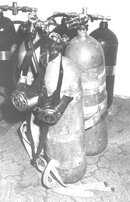Here are several comments related to this discussion. To the basic question, US Navy Sea Lab I and II crews used HeO
2 (not trimix) on Scuba with double hoses, mostly for crew transits and quick support jumps. They had very long lists of failures on both of these projects, but Scuba regulators were not listed on any of the reports I saw. There was a period where I often had weekend duty at the Submarine Development Group HQ in San Diego with almost nothing to do. I spend most of my time in the tech library reading through unclassified reports and looking at photos from the Sea Lab programs and the Trieste missions on the Thresher and Scorpion.
Anomalies occur with all regulators; and all other valves for that matter. Many valves will leak due to the lower density of helium. Weird harmonics can (rarely) occur as gas density changes due to compression and mixes. I have seen some cases where regulator performance will improve at greater depths the test medium was always HeO
2 in this case but likely would occur with others.
I remember reading about an incident where a semi-closed circuit rebreather was sent down in a chamber through an equipment lock. Like many units of the day, they had a manual valve that could be closed on the mouthpiece. The tanks were off and the crew forgot to open the mouthpiece valve before closing the door. Photos showed part of the inhalation breathing bag was forced up into the corrugated supply hose. I "assume" that the hose did not collapse. Mushroom check valves would have prevented the same thing happening to the exhalation bag.
My "guess" is these bags are a whole lot tougher than human lungs so I doubt that hose collapse from pressure differential would ever occur
before someone is dead anyway. Hoses were smaller then
more like the diameter of a double-hose regulator than on modern rebreathers.
With my experiments, there is no noticeable difference with a hose in hose set up until one is in a head down position.......senses make you feel like your breathing a hybrid single/double hose, at least to me...........but head down, the breathing effort is the same as head up........so there is some value however, I'm not sure the expense and effort is warranted............it's easier to teach someone to just roll to their side for extra air head down...........
The practical illustration used in my first dive class was watching the instructor kneeling on the pool bottom (head up position) and taking his double hose mouthpiece out. Raising from chest to above his mouth (and regulator can) illustrated to all of us the differential pressure acting on the regulator diaphragm. By 1962 all double hoses had mushroom check valves on both sides of the mouthpiece where earlier models didnt always react so predictably.




